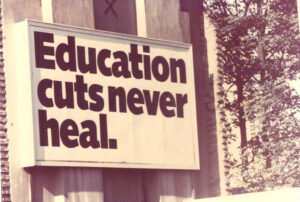When you think about making the transition to be a worker self-directed nonprofit, or even just any democratic leadership model, or really any leadership model transition, it really starts in the space of conversation and making sure to give yourself time to have those conversations.
The transition to a worker self-directed nonprofit model can’t just be about what you don’t want to be; it has to be about what you want to be.
And of the case studies, all of the case studies that did transition did so at a time of other transition as well. So, for PLAN [Post-Landfill Action Network], it was the coexecutive directors transitioning out. For some of the other organizations, it was a shift in the mission or just a realization of unsustainability within the current structure of the organization. So, [this means] looking to the worker self-directed nonprofit model as not only an opportunity to shift structure but also an opportunity to address goals that have been existing within the organization already but have not been able to be realized.
So, I think a big part of the beginning of this transition is identifying if those goals are there. Is the intent there? Is the desire there for this shift among the team? And leaving yourself space for folks to voice their concerns and their fears and their goals.
Sign up for our free newsletters
Subscribe to NPQ's newsletters to have our top stories delivered directly to your inbox.
By signing up, you agree to our privacy policy and terms of use, and to receive messages from NPQ and our partners.
I think in one of the interviews, someone said that the transition to a worker self-directed nonprofit model can’t just be about what you don’t want to be; it has to be about what you want to be—what you want to embody. And I think that’s a really important thing to think about.
And in thinking about the actual transition, I think about it in kind of two separate directions. There’s the logistical piece of the transition, and the logistical piece of the transition is the writing of policies, is the understanding what gaps exist in roles on the team and trying to identify how to fill those gaps, re-delegating some roles, maybe changing some people’s job descriptions. It’s that like logistical jigsaw puzzle of making sure that the responsibilities of the organization will be upheld. It’s also the work of digging into some of those policies.
And I’m sure folks who have read a personnel policy or bylaws, they talk a lot about the executive director. You’ll ask the executive director. You’ll get confirmation from the executive director. So, every time it says, “the executive director,” you have to go in and replace that. Who? What entity is now responsible for that decision? What process is now responsible for that? And each of those shifts is sometimes its own whole conversation. So, making sure to give yourself that time to really dig into that and not just replicate the same model of diverting decisions, but making sure there’s an intentionality within that.
And then the other piece of it is the transition of relationship. So, this does fundamentally change the relationships of folks in an organization. And one other quote that came up in interviews was, “To move at the speed of trust.” I think this came up actually multiple times in the interviews because this element of trust is so important—that really making sure to give time and dedicated space to ensuring that that folks feel heard, and folks feel like they have the space to dissent and bring up concerns. That will start to build the trust. And a lot of times, also, conflict builds trust. Working through conflict together and giving the conflict the space and the respect that it needs to be generative.











